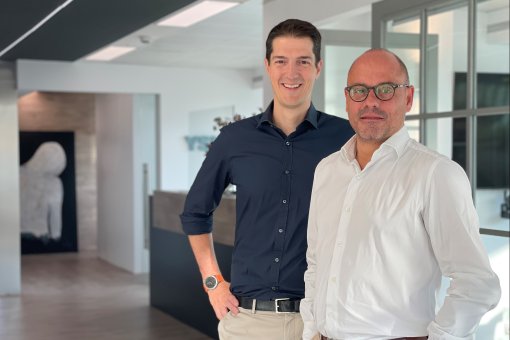Images
Participants



Contact

IRB Barcelona starts a project with the long-term goal to achieve an injectable frataxin treatment able to reach the brain.
Frataxin is the protein that is reduced in those affected by this rare and degenerative disease, which has no cure.
The patients’ associations Babel Family and ASOGAF in Granada provide the funding for the initial 18 months of this challenge.
The associations of patients and families Babel Family and the Asociación Granadina de la Ataxia de Friedreich (ASOGAF) channel 80,000 euros of their donations (50% from each organisation) into a new 18-month project at the Institute for Research in Biomedicine (IRB Barcelona). The project specifically aims to complete a step necessary in order to move towards a future frataxin replacement therapy for the brain, where the reduction of this protein causes the most damage in patients with Friedreich’s Ataxia.
The study is headed by Ernest Giralt, head of the Peptides and Proteins Lab, who has many years of experience and is a recognised expert in peptide chemistry and new systems of through which to delivery drugs to the brain, such as peptide shuttles—molecules that have the capacity to carry the drug across the barrier that surrounds and protects the brain. Since the lab started its relation with these patients’ associations in 2013*, it has been developing another two projects into Friedrich’s Ataxia.
Features of Friedreich’s Ataxia
Friedreich’s Ataxia is a hereditary degenerative disease that causes progressive lesions in the nervous system, impairing the coordination of movement and causing muscle weakness, speech problems, and heart conditions. This disease normally appears between the ages of 5 and 25.
“Unfortunately, there are no efficient treatments for the central nervous system for this disease or for others such as Alzheimer’s and Parkinson’s. Getting drugs into the brain continues to be a challenge, but we are hopeful that a cure will eventually be discovered. We believe that the peptide shuttles developed by researchers at IRB Barcelona have enormous potential, although we are aware of the many obstacles to overcome along the way. We consider these molecules to be a good starting point,” say Mª Luz González, and Teresa Gilabert, spokespeople of the associations Babel Family and ASOGAF, respectively.
Two people in every 100,000 are affected by Friedreich’s Ataxia, and this disease hits only those of European origin (Caucasians). Spain registers a higher incidence, with an estimated 4.6 cases per 100,000 population. The disease is caused by a defect in a gene, namely frataxin, which results in reduced levels of this protein in the body, particularly affecting the brain, spinal cord and muscles.
Second of four stages
The long-term goal of the project is to develop a frataxin therapy that reaches the brain—like the injection of insulin for diabetics. In addition to Ernest Giralt, the team comprises the scientists Meritxell Teixidó and Macarena Sánchez. “Our peptide shuttles can cross the blood-brain barrier, they reach the central nervous system, and they have not showed signs of toxicity in preliminary studies to date. The challenge in the coming months is to attach frataxin to the shuttles in order to transport the drug across the blood-brain barrier and to test their capacity in cell models,” explains Meritxell Teixidó, Associate Researcher at IRB Barcelona and head of this research line.
Thanks to a project funded by the RecerCaixa Programme since 2015, the scientists are now able to produce frataxin in bacteria. “This was the first step in order to envisage this second project, after which there will be two more stages before we can talk about success,” says Ernest Giralt. Frataxin not only has to cross the blood-brain barrier but also the plasma membrane of cells, after which it must enter mitochondria—the organelles where it exerts its affect. “We will not be tackling these two stages now,” explains Giralt.
In this project, IRB Barcelona will explore the transport of both the whole fraxatin protein and fragments. The team explains why this approach will be taken. On the one hand, the cost of producing fragments of fraxatin would be much lower than those associated with the whole protein. On the other hand, breakthroughs in knowledge about the mechanism of action of this protein are expected, which will allow identification of the regions of the protein that are essential for its activity with regard to Friedreich’s Ataxia, thus paving the way to the therapeutic use of protein fragments.
“I consider it feasible in the long-term to achieve a treatment because we are not working alone. Although only a small number, other groups worldwide are addressing this disease and sharing knowledge, and this collective effort will favour the possibilities of this treatment or other therapeutic options. We don’t know where the treatment will be discovered but we are optimistic that one will be found,” says Giralt.
Mª Luz González, from the Babel Family, concludes that “it is crucial—especially in the case of rare diseases—that patients’ associations channel funds into research and increase public awareness of this condition, after all we are all potential victims. Also, this project does not benefit only Friedreich’s Ataxia. Research into health is in everyone’s interest.” Teresa Gilabert, from ASOGAF, adds that “promoting and collaborating with a research project motivates us to continue the fight.”
* Friedreich’s Ataxia at IRB Barcelona:
-Patients and scientists join forces to tackle Friedreich's Ataxia (Nov 2013)
-International patient advocates partner to fund Spanish gene-therapy project to treat Friedreich's Ataxia (Jan 2014)
-Ambulances for the brain supported by the RecerCaixa Programme (March 2015)
About IRB Barcelona
Created in 2005 by the Generalitat de Catalunya (Government of Catalonia) and University of Barcelona, IRB Barcelona is a Severo Ochoa Centre of Excellence, a seal that was awarded in 2011. The institute is devoted to conducting research of excellence in biomedicine and to transferring results to clinical practice, thus improving people’s quality of life, while simultaneously promoting the training of outstanding researchers, technology transfer, and public communication of science. Its 23 laboratories and seven core facilities address basic questions in biology and are orientated to diseases such as cancer, metastasis, Alzheimer’s, diabetes, and rare conditions. IRB Barcelona is an international centre that hosts more than 400 employees and 36 nationalities. It is located in the Barcelona Science Park. IRB Barcelona forms part of the Barcelona Institute of Science and Technology (BIST) and the “Xarxa de Centres de Recerca de Catalunya” (CERCA).
About IRB Barcelona
The Institute for Research in Biomedicine (IRB Barcelona) pursues a society free of disease. To this end, it conducts multidisciplinary research of excellence to cure cancer and other diseases linked to ageing. It establishes technology transfer agreements with the pharmaceutical industry and major hospitals to bring research results closer to society, and organises a range of science outreach activities to engage the public in an open dialogue. IRB Barcelona is an international centre that hosts 400 researchers and more than 30 nationalities. Recognised as a Severo Ochoa Centre of Excellence since 2011, IRB Barcelona is a CERCA centre and member of the Barcelona Institute of Science and Technology (BIST).





